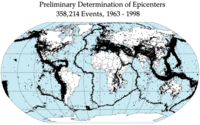
Photo from wikipedia
An outstanding question for induced seismicity is whether the volume of injected fluid and/or the spatial extent of the resulting pore pressure and stress perturbations limit rupture size. We simulate… Click to show full abstract
An outstanding question for induced seismicity is whether the volume of injected fluid and/or the spatial extent of the resulting pore pressure and stress perturbations limit rupture size. We simulate ruptures with and without injection‐induced pore pressure perturbations, using 2‐D dynamic rupture simulations on rough faults. Ruptures are not necessarily limited by pressure perturbations when (1) background shear stress is above a critical value, or (2) pore pressure is high. Both conditions depend on fault roughness. Stress heterogeneity from fault roughness primarily determines where ruptures stop; pore pressure has a secondary effect. Ruptures may be limited by fluid volume or pressure perturbation extent when background stress and fault roughness are low, and the maximum pore pressure perturbation is less than 10% of the background effective normal stress. Future work should combine our methodology with simulation of the loading, injection, and nucleation phases to improve understanding of injection‐induced ruptures.
Journal Title: Geophysical Research Letters
Year Published: 2020
Link to full text (if available)
Share on Social Media: Sign Up to like & get
recommendations!